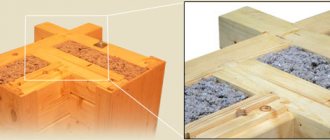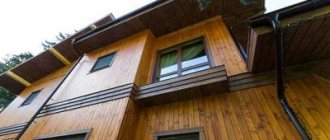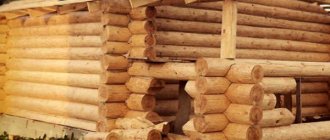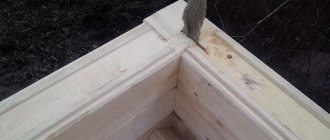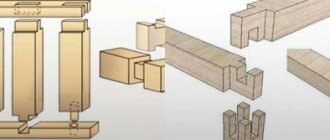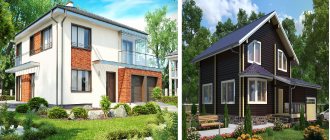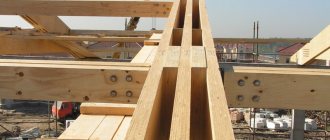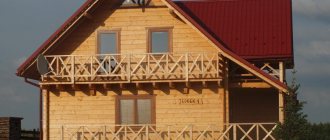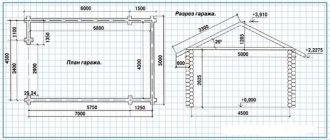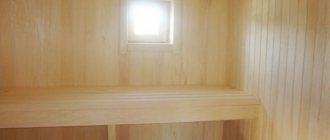Disadvantages of houses made of timber, how to properly protect the wood. Shrinkage, choice of adhesive composition, how to properly heat and insulate houses made of timber. Correct installation of sound insulation and electrical wiring.
Houses made of timber look graceful and have an attractive appearance, but behind this alluring mystery there are certain nuances, lack of knowledge of which will lead to disappointment in houses made of wood and will discourage for a long time the desire for long-term living in a house made from the gifts of the forest.
Houses made of timber have their drawbacks, but knowing certain rules, you can reduce them to a minimum, namely, what safety rules exist in a wooden house, for which they use the installation of a plasterboard false wall. Why is it necessary to protect wood with antiseptics and what does proper ventilation provide, what is the degree of shrinkage of a house made of profiled timber, what needs to be done to minimize the formation of cracks between the beams. Why is it not beneficial to use tow for insulation and why is phenol dangerous as a wood treatment agent?
What is the degree of drying and swelling of a wooden structure, why is it so important to insulate the house from indoor humidity. What are the natural properties of timber, how is it dried for long-term use. Why is sound insulation so important and how does it affect the noise level inside the room, how electrical wiring is installed to minimize the possibility of a fire hazard. What is the cost of houses made of timber and what differences exist in the materials used. How to warm up a wooden building to prevent cracks in the timber as a result of a sharp temperature change.
Why is impregnation of timber so important, how environmentally friendly is it, what is the danger of choosing low-quality glue in the process of gluing timber.
Safety rules in a wooden house
If you decide to build a house from timber, you should first study the reviews. After all, it is consumers who are most accurately able to assess the quality characteristics of this material.
If you decide to purchase a house made of timber, the pros and cons (you should carefully study the reviews in advance) of such a building must be carefully weighed. Another disadvantage of the described structures is that the installation of wiring requires compliance with strict rules. This is due to the fact that wiring is the main source of ignition.
Thus, hidden wiring installed in the ceiling, floor, and ducts must be protected with iron pipes, which is often a rather difficult task to implement. Among other things, it is quite expensive.
Most often, the wiring is laid in an iron corrugation.
However, this approach is unacceptable in some cases. If you do not have enough experience and knowledge in this field, then you will have to take the help of professionals, which involves additional costs. This can be considered a disadvantage of wooden houses.
It is worth mentioning that laying electrical wires inside timber walls is considered a rather difficult task. To do this, it will be necessary to drill channels during the construction of the house, and then install pipes in them, taking into account the future shrinkage of the building. An ordinary home master cannot cope with this. Therefore, the construction of a wooden structure is most often entrusted to professional builders. If you decide to buy a house made of timber, reviews and price, of course, interest you. As for the cost, it can be equal to 400 thousand rubles.
If you want to reduce the cost of construction, you can build the foundation yourself. Returning to the issue of electrical wiring, we can highlight another disadvantage, which is expressed in the fact that the wiring to sockets and switches is most often open in wooden houses. This provides a not very aesthetic appearance of indoor walls.
The unattractive appearance obtained after laying the wiring can be corrected by installing a plasterboard false wall. However, it is necessary to take into account that in this case the usable area of the house will be somewhat reduced, which quite often does not please the modern consumer. However, in this case it will be possible to hide the wiring between the drywall and the timber.
Good and bad opinions
When deciding to build such a house, it would be right if the potential developer reads the reviews of the owners of such houses. Such reviews are collected on various construction forums or on the websites of wall timber manufacturers and contracting firms.
Feedback from real owners of wooden houses will be able to make it clear to the developer what he can expect as a result of investing his funds in the project, what time it will take and what pitfalls await him along the way. Statistics show that 80% of users trust a product with a rating of at least 4 out of 5 stars.
Research conducted in 2022 revealed that the average rating given by owners of such modifications of wooden houses is above 4 and less than 6% of them have disastrous experience in construction and operation.
When making such a responsible decision, the developer must hear the opinion of not only users, but also builders. As a rule, reputable companies that build houses from timber on their websites or specialized forums inform readers about developments in this direction.
Real owners
Some users who already live in built houses rate the quality, practicality and price of such a structure as 5 points out of a possible five.
One of the users told about his experience of building a house made of 200x200 mm profiled timber.
The house has been in operation for more than 3 years. Construction took place in February, the box with the roof was completed in a month, after which the house was set for shrinkage.
The house has been treated against fungus and mold with Tikkurila. It was processed completely together with the timber releases so that it would not crack, however, this did not help; cracks still appeared, but not critical.
The advantages of such house designs include the possibility of obtaining excellent favorable temperatures in the house and an attractive appearance. The disadvantages are certain difficulties in electrical wiring; it needs to be laid in iron pipes, which is difficult and expensive.
Other users include the following advantages of timber housing: natural 100% solid wood with 0% added glue, environmental safety. Smooth areas create an attractive appearance for housing construction.
Installing a profiled beam with a gap of 3 mm with a self-expanding tape seal creates a warm structure with a complex “labyrinth” lock in 2 planes, which is much better than a rounded log in terms of thermal protection and requires 40% less energy consumption for heating than a house made of that log same sections.
Minimal shrinkage, which does not require large volumes of caulk. The possibility of cracks forming is much lower, since tension is removed from 4 sides. Factory autoclave impregnation of timber with fire retardant fire retardants ensures the durability and safety of the walls. Developers include a long shrinkage period as a disadvantage.
Cutting opens the pores of the wood for bacteria and insects to enter, which can only be qualitatively eliminated by autoclave impregnation of the material.
Another developer shared his experience of building from profiled timber. The house was built 6 years ago on our own. A careful selection of material was previously carried out, determining the humidity and configuration of the lock; the “Finnish” profile was chosen. Despite the fact that the estimated construction period is 1-1.5 months, they completed it over the summer.
Metal studs were used for fastening; after completion of the work, the surfaces of the walls were covered with Antex Titan impregnation to prevent fire and mold. The color of the house has not changed.
The finishing was carried out a year later, the actual shrinkage was 10 cm, which is not bad considering the expected 18 cm. When installing the box, polystyrene foam was placed between it and the beam so that during further installation it would be compacted by compression. Living in the house is year-round. There are no complaints. The building darkened, but evenly.
More detailed reviews can be read on the forum.
Builders
Before you start building a house from timber, you need to read the reviews of professionals, here are some of them:
The company ZAO EkoSpetsStroy believes that laminated veneer lumber has more disadvantages than advantages.
Since its strength depends on the quality of the glue used at different temperature changes. Low deep biostability during operation is less than 6 mm, which contributes to the low service life of houses. Reviews can be found on the forum.- On the contrary, AnizaGroup considers the advantages of laminated veneer lumber to be its low humidity and predictable shrinkage. The disadvantages are the need to choose a supplier of high-quality timber, glued using environmentally friendly glue. The forum provides detailed reviews.
- The RUMAX company believes that when assembling such a house, it is important to correctly calculate the volume of material so as not to constantly transport it.
Complete a preliminary design to ensure the foundation is properly poured. Let the box sit. Inner and outer walls shrink unevenly, and doors may become stuck. When installing a roof with soft tiles, it is better not to work in winter. Select one turnkey team to resolve claims between performers. Reviews can be read on the forum.
The need to protect wood
If you are interested in houses made of timber (Pestovo), reviews will help you study all the shortcomings of the material; for this you only need to read them in this article. It is important to take into account another disadvantage of wood, which is that it is undesirable to expose this material to excessive moisture, in which case the walls will begin to rot, bugs and all sorts of harmful microorganisms may appear in them.
Manufacturers, however, have taken this feature of the timber into account; they treat it with antiseptics during the production process. Houses made of laminated veneer lumber, reviews of the owners of which you will read in the article, are also treated with special substances. The consumer must take into account the need for proper ventilation of the walls so that they do not become saturated with moisture. The disadvantage of wood treated with antiseptics is that such substances are not very beneficial to health.
Beam and frame: types and quality of material
To build a practical and modern home, you should pay close attention to the material.
timber
Several types of timber are used in construction, the first two are recommended for country houses:
- Regular (massive). It is obtained after minimal processing of a raw log on a woodworking machine, where it is given a cross-section (square or rectangular). Product humidity may exceed 20-30%.
- One-piece profiled. Wooden blanks are given a more complex profile shape (a tongue-and-groove system that allows rigid connections of structural elements).
- Glued. The humidity of the workpieces (lamella boards made of coniferous wood) is reduced to 10-12% in the drying chamber. Then the lamellas are selected according to quality (the outer ones can be made of larch, the inner ones can be made of pine) and glued together under pressure.
Frame technology
The design is based on a frame, wooden (from kiln-dried lumber), metal or sandwich panels. The frame is filled with insulation (ecowool, polystyrene foam, mineral wool) and covered with plywood, cement-bonded or oriented strand boards.
Board in an industrial drying chamber Source ostwest.su
About wood quality
The quality of the lumber is the quality of the construction, so they are chosen carefully. The market offers materials made from both raw and dried wood.
Natural moisture content (NW) lumber is a popular option. It undergoes minimal processing (requires minimal investment) and is therefore cheap. This is its main advantage.
EB timber and boards are often used in modern construction (timber and frame houses, respectively). Natural processes occurring in raw wood lead to unpleasant consequences:
- Shrinkage (shrinkage). Once solid timber walls are assembled, they will lose EB and shrink in size. This feature makes it necessary to take a technological break in construction (at least a month or two). Walls made of laminated veneer lumber exhibit minimal shrinkage. Using raw material for framing will lead to an uneven change in the size of the boards (shrinkage is different for all boards, it is more pronounced in thickness and width). Cracks cannot appear at the joints of the beams, since a special “force” fastening is used
- Bio-attack. Mold and fungi thrive in EB lumber. If damp walls are not left to dry and insulation is started immediately, moisture will linger and create an ideal environment for the development of microorganisms.
- Changing geometry. Touches the boards. During the drying process, internal stresses appear in the wood; the board may bend, warp or twist. This doesn't just happen with stack drying (air drying); the racks in the finished frame can be unscrewed until a gap appears.
The amount of cracking depends on the quality of drying of the timber Source stroyka.ru
The cost of high-quality lumber includes treatment with an antiseptic; impregnation often occurs under pressure, which ensures deep penetration of the mixture into the wood. This method is not applicable to damp wood; manual processing of its surface affects only the surface layer and does not effectively protect against rot. An important issue is proper storage; Glued laminated timber will be irrevocably damaged if it is left on a construction site for the winter.
Disadvantages of houses made of glued profiled timber
A house made of profiled timber, reviews of which we are reviewing, may also have certain disadvantages. One of them is that all kinds of resins are used in production, which can be toxic. It is important to choose quality material, as some manufacturers use processing agents that release phenol.
If you are considering houses made of laminated veneer lumber, reviews from owners should not be ignored. After all, it is important to know the disadvantages of this material. Many consumers say that if you do not take care of such a building, it will begin to rot over time. In addition, by purchasing untreated profiled glued material, you expose your home to a fire hazard.
Types of timber for log houses
Houses can be built from three types of timber:
- profiled;
- sawn;
- glued.
Each type has both advantages and disadvantages, which significantly affect not only the construction process, but also operation.
sawn
This type is produced using the simplest technology, which involves removing the edging from all four sides of solid wood without additional processing. Complex equipment is not required to carry out these actions, which is why sawn timber is found on the market more often than others.
Its advantages:
- accessibility - the material is available almost everywhere, even to order it is made faster than others;
- low price - the wood is not dried in a special chamber, is not treated with antiseptics and other means, therefore it costs much less than other types;
- environmental friendliness - due to the absence of impurities and chemical impregnations, such timber is considered the safest for humans, while regulating the level of humidity in the room, absorbing excess moisture.
Flaws:
- The complexity of the installation process. The surface of the wood is uneven, it does not have longitudinal profiled grooves, so the finished wall is of poor quality.
- Increased construction time for a house due to shrinkage. After the construction of the log house, sawn timber must be left to dry for at least a year. Before finishing and installing windows, it is still necessary to fill the seams with sealant and perform additional work.
- Appearance of cracks. Due to shrinkage, wood cracks, bends and twists appear.
- Costs for finishing and thermal insulation. Externally, sawn material is unattractive and therefore requires finishing, both internal and external. Numerous cracks that appear as a result of shrinkage also require insulation.
- Lack of protection against bacterial infections and insects. Fungus, rot, mold - all this can appear on the tree if it is not treated with special solutions. And these costs are not only temporary, but also monetary.
Upon closer examination, the disadvantages of sawn timber outweigh its advantages. To achieve high-quality construction of a house from this material, you will have to spend extra money. And then the question arises: isn’t it better to immediately purchase another type of wood?
Profiled
Profiled timber is a solid beam that has undergone a complex processing process on modern machines, resulting in high-quality side edges and a cross-sectional profile. It is dried in special chambers, making it much less susceptible to shrinkage than the sawn version.
There is a relief on the upper and lower surfaces of the material. When laying one crown on top of another, they coincide, ensuring density. This way the elements are fixed more securely and prevent water from leaking in. The profile may be different, it all depends on the manufacturer.
Advantages:
- stable fastening of rows to each other when laying a log house;
- the joints are tight without additional labor costs;
- shrinkage reaches a maximum of 5%, usually less;
- the timber looks aesthetically pleasing and requires virtually no finishing;
- ensuring good thermal insulation properties;
- the house is assembled as quickly as possible according to the type of designer;
- environmental friendliness - profiled timber regulates the level of humidity in the room.
Flaws:
- the cost is higher than that of non-profiled wood;
- mobility with seasonal changes in humidity.
Compared to sawn timber, profiled timber is preferable. However, there is another type that also needs to be considered before purchasing material for construction.
Glued
Such timber is made by gluing together several lamella blanks of wood of different species. Typically their number ranges from 3 to 8 elements. Only well-dried material and special glue are used in production. The required profile is given to the timber after gluing is completed.
Its advantages:
- reducing the time required to build a house - there is no need to wait until the shrinkage process is completed; after erecting the log house, you can immediately begin installing windows and doorways;
- during operation, a structure made of laminated veneer lumber retains its original dimensions;
- the appearance of the finished wall allows you to proceed to painting or applying varnish without preparatory finishing;
- cracks do not appear due to the fact that there are several lamellas in one element;
- strength and durability of the structure;
- high thermal insulation rates;
- the ability to order a longer beam - the length of the part can be up to 20 m, which is impossible to achieve when using solid wood.
There are also disadvantages:
- high cost - on average, this variety is 1.5-2 times more expensive than its analogues;
- low environmental friendliness - such a wall will control the level of humidity in the house to a minimum;
- the technology appeared relatively recently, so there is still no accurate practical data on the behavior of the structure after 50-70 years.
During production, laminated veneer lumber is treated with antiseptics, fire retardants, and insecticides. Therefore, during operation it requires a minimum of maintenance, providing residents with comfort and safety.
Key Features
Houses made of timber certainly deserve significant attention.
This technology is quite well developed in Russian practice, so modern construction practices have made such buildings not only quite cheap, but also comfortable for living in all respects.
It is quite difficult to convince many old-school enthusiasts: they perceive natural wood as the only right solution, capable of competing with even the most advanced materials.
Such houses are really good, but they have quite obvious disadvantages that are discovered both at the construction stage and during operation.
Pitfalls are inevitable, but having reliable knowledge, it is much easier to reduce all such effects to a minimum.
You cannot ignore them if you are seriously concerned about construction and want your home to serve you for a really long time.
It is no secret that the overwhelming majority of houses in this category are economy class solutions. Behind the warmth and low cost of such buildings lies a lot of nuances that can become a headache. First of all, the specificity of the material itself plays a role.
Most often, when building a house, we use the most familiar timber of natural moisture, which, like any tree, is not very impressive in some properties, first of all, we are talking about strength and elasticity. Further, timber, both profiled and edged, requires time to shrink; in the future, you can wait a year or even a year and a half.
After this, if all technologies are followed, the material dries out to a certain extent, as a result of which cracks appear, the size of which is unpredictable and often exceeds the permissible limit. At a certain point, the need for additional maintenance arises: cracks should be caulked, window and door frames should be adjusted to the changed terrain. In itself, deformation due to weather phenomena usually does not frighten owners, but for some, and this is understandable, this type of house seems somewhat unaesthetic.
Evgeniy Filimonov
Ask a Question
A wooden house significantly changes its geometry: it dries out by 10% in winter and swells by 15% by summer. This problem should be taken into account when forming gaps and door hinges. If the calculation is incorrect, the door may well stop opening by summer.
All this is extra hassle, to which the owners of such homes are already accustomed. It is worth noting, however, that edged timber is much more susceptible to the appearance of a large number of cracks.
The profiled analogue is, of course, more expensive, but behaves much better in practice. Overpaying a certain amount for it is a fairly good idea, since over time it will become obvious that this expenditure was not in vain. Despite the fact that timber in the form of timber retains heat perfectly, modern frame houses are often in no way inferior to similar competitors.
With the help of insulation, you can achieve excellent properties in maintaining a favorable temperature indoors. That is why the demand for frame houses today is simply huge; unlike wooden ones, they require much less labor for construction.
Features of the production of laminated timber
Despite the fact that most famous manufacturers keep the technology for producing laminated veneer lumber a secret, the main stages of production are the same everywhere - the only difference is in the details.
Mostly in the production of laminated veneer lumber, spruce and pine wood is used - the most common and affordable species, the quality of which meets production requirements. From the logs, edged beams are obtained, which are sawn into boards. Because material with natural moisture is not suitable for gluing (in addition, it has a high shrinkage), all boards are sent to special chambers for drying. Soft drying modes allow you to achieve a uniform 8, 10 or 12% moisture content of the boards.
Each board undergoes inspection. At this stage, wood defects are identified and immediately eliminated. To intensify the process of manufacturing laminated veneer lumber and reduce the amount of waste, the boards are spliced to a certain length - most often up to 12 m. The finished lamellas are sent for gluing.
After applying glue for laminated timber to the surface of the lamellas, they are placed in a special press. The 12 m beams obtained in this way are sent for profiling, cutting cups and marking - in accordance with the project of the future house.
You can learn more about the production technology of laminated veneer lumber in the video below.
Humidity
Any material of wood origin is very strongly affected by water and steam. On an intuitive level, it is quite difficult to understand exactly what processes are responsible for the destructive impact, however, the obvious need to insulate the tree is beyond doubt. One of the most interesting effects in this regard is the dew point. This is a specific physical phenomenon when, at sub-zero temperatures outside, a layer of space appears in the walls of the house, in which ice turns into water due to the difference. Rotting inevitably occurs, which leads to rapid wear of the wood. To neutralize this process, it is recommended to first completely insulate the walls of the house from moisture from the inside. This requires the painstaking work of a person with experience.
Poorly sealed cracks can also lead to the house being blown through by the wind, which can significantly disturb residents during a snowstorm. Strict adherence to this simple but rather specific technology is important.
Glued laminated timber does not have all these disadvantages
No it's not like that. Unfortunately. Let's break it down point by point:
- Is there any shrinkage? Theoretically, no. But this is a tree, so in practice the probability still remains.
- Is he as cold? Yes.
- Gaps between crowns? According to the sellers, no. In the case of the profiled one, they definitely exist. You won't see the street in them, but they will be ventilated.
- Sealants, varnishes, paints, outside, inside - all this remains.
- Another drawback is added - high cost.
Don't listen to salespeople.
Natural properties of wood
Timber is a fairly versatile material; it is considered convenient to work with; most often it is considered as an environmentally friendly option, completely safe for human health. It is worth noting that all of these statements require significant qualifications.
Modern store-bought timber is dried in a not entirely natural way: in a very short period of time it is dehydrated in ovens at high temperatures.
Externally, the material looks almost the same, but the internal properties deteriorate:
- In this process, resin crystallizes in the wood, which negatively affects strength and resistance to decay.
Environmental friendliness is a relative concept, since wood remains completely safe for human health no longer than before the first treatment with impregnations and fire retardants.
Varnishes are also synthetic substances, and such construction is extremely rare without them.
Soundproofing
Today, many construction organizations look at this parameter especially strictly, since it really affects the quality of living. In a completely wooden house, external sounds can behave completely differently, but most often you have to deal with the phenomenon when they are not only not damped, but are also enriched with new overtones and noise. It’s hard to say how bad it is, but for some owners, the creaking of floorboards and the howling of the wind are exactly what can irritate and bother them.
Cost of houses made of timber
It is worth recognizing that modern frame houses are often cheaper. A good wooden hut made from laminated veneer lumber is often expensive due to materials and finishing.
Materials of artificial origin will likely continue to push analogues out of the market. Edged timber is more economical, but it is extremely problematic to make a luxurious house from it in a short time with a small team.
When trying to pay less there is always a risk of losing in quality. It is typical for Russian practice when defective timber, purchased at a low price, eventually begins to delaminate due to the fact that low-quality glue was used in it.
It is strictly recommended to take materials only from trusted suppliers.
Types of timber
Conventional timber, produced at almost every sawmill, is not a technologically advanced material; it has a number of disadvantages and it is not advisable to delve into an outdated category. For everyone who dreams of a wooden house with a unique microclimate, but does not want to live in a hut made of rounded logs, manufacturers offer two options:
- laminated veneer lumber;
- profiled timber.
These are more advanced types, with many advantages, which not least contributed to the surge in popularity of wooden houses. These materials have a lot in common, but there are also fundamental differences, and before making a choice, you need to clearly understand what we are talking about.
Differences in materials
Almost always, only the use of profiled timber makes it possible to quickly and efficiently adjust all elements. In addition, quite intricate structures can be made from this type of material, which is problematic when working with ordinary timber.
Glued laminated timber is ideal from the point of view of construction productivity and at the same time the least environmentally friendly: almost all impregnations that prevent rotting in it contain phenol.
Evgeniy Filimonov
Ask a Question
Ordinary timber undergoes minimal chemical treatment, but due to the lack of grooves for fixation, the technology becomes significantly more complicated; assembling the house will take much longer. When using it, you will have to take thermal insulation much more seriously.
Trying to save on one thing when building a house from timber, it is very easy to burn out on another - all expense items are significantly interrelated.
Popular questions and answers
Pavel Bunin, owner of the Bansk bath complex:
Is it possible to live in a house made of timber in winter?
Yes, you can. A house made of timber retains heat well even without a layer of insulation. This is its great advantage over a brick or concrete structure. A wooden house heats up quickly and cools down slowly, and in addition, it absorbs moisture from the air well or releases it when the air is dry. With sufficient wall thickness, a house made of timber can retain heat even at 40 degrees below zero. To reduce heating costs, it is advisable to insulate the house. Insulation is carried out outside the house. For these purposes, you can use slabs of mineral wool 5-10 cm thick. It will be cheaper if you cover them with siding on the outside, but you can also use wood coverings, for example, imitation timber.
Does timber require maintenance?
Since timber is a natural material, it naturally needs regular maintenance.
For example, our ancestors used winter forest to build houses, since it contains less moisture and practically no harmful microorganisms and insects. Currently, winter wood is also used in construction, but various antiseptics are also widely used. To protect the timber from precipitation and direct sunlight, you can use varnishes, oils and paints. This not only guarantees safety, but also gives additional attractiveness to the house. It is advisable to use antiseptics every two years, and renew paintwork every five years. The timber is also treated with fire retardants - substances that protect wooden buildings from fires. You only need to use this product on the internal parts of the house in order to increase the time they resist fire. From the outside, such treatment is ineffective and will simply lead to unnecessary costs.
Which timber is better to choose?
The following types of timber are used in the construction of wooden houses: regular, profiled and glued.
An ordinary beam (four-edged) is a log sawn on four sides. It is cheaper than other types because it has not been processed or dried. This creates additional difficulties in work. Profiled timber is a much higher quality product. It is already dried, so it does not shrink much. There may not be any gaps between the crowns. The mounting grooves are also pre-fabricated at the factory, making assembly easier.
Glued laminated timber is the most technologically advanced product. But its price is 3-4 times higher than that of ordinary timber, which is a significant disadvantage.
If we compare price and quality, then the best option, in my opinion, is to use profiled timber. Its reasonable price is combined with fairly high quality.
Heating specifics
Taking into account the fact that the house has had time to settle, and the density of the tree has returned to normal, additional monitoring of its condition is required in the first winter.
The first heating season is carried out under careful control: the temperature inside should not exceed 20 degrees, otherwise deformation is possible.
The building needs to be warmed up slowly and gradually; sudden changes can cause cracks to appear in the timber at an extremely inconvenient moment in time.
Installation of heating systems must also take into account the specifics of natural wood and its possible deformations.
Disadvantages of a house made of timber
You, of course, ask, can such an ideal material have drawbacks? Alas.
- If the manufacturing technology of a profiled element is violated, it loses a number of its positive properties. This applies primarily to drying it.
- The second negative quality of laminated laminated timber, which can appear if it is not manufactured correctly, is the impregnation with which it is treated. If this is not done, it will quickly begin to rot. And such impregnations emit phenol, which is undoubtedly harmful to human health. Moreover, impregnations that emit less phenol are much more expensive, which means that careless manufacturers will use the cheapest ones. This can be avoided by using materials only from reputable manufacturers.
- And the third negative quality, which is much inferior to a rounded log, is its high cost. Of course, it is worth noting that here we are talking about the lack of a glued link. Ordinary material outperforms rounded logs in price, but the costs that will be incurred when insulating such a house practically nullify this gain.
Disadvantages of a house made of ordinary timber:
- Strength - when dry, they deform, of course not like rounded logs, but they still lose their shape and rot.
- Thermal insulation - requires additional caulking, requires additional thermal insulation of the walls.
- Prostate in installation - It has a large length, which does not allow one person to install such a beam.
- Fire safety - high fire hazard, since the timber is ordinary wood without all kinds of processing.
- Cost-effective - requires additional costs for external and internal decoration, for wall insulation.
Disadvantages of a house made of laminated veneer lumber:
- Environmental friendliness is the downside of this material. That when gluing they use resins that emit slight toxicity. When treating for fire protection purposes, careless manufacturers use phenol-releasing products.
- Durability - if such a house is not looked after and treated with special compounds, it will also begin to rot over time. This refers to its shortcomings.
- Fire Resistant - If not maintained or treated. It will burn just as well as normal.
- Cost-effectiveness - Quite a high price, which includes the price of lumber and adhesives used in manufacturing. The process of manufacturing such material is more expensive.
Many buyers get into trouble when purchasing houses made of ordinary materials, and are very surprised when a “tidy” amount of money is spent on insulating such a house. To avoid this situation, we advise you to immediately add the price of additional finishing to the price of regular timber.
Buildings made of glued material do not need such additional systems, thanks to the thermal lock that was developed in them. On average, a turnkey house made of timber of 75 sq.m will cost from 1.5 million rubles, and from laminated timber of the same area from 2 million.
The difference is certainly big, but it disappears when you start doing additional finishing.
General advantages of timber
The external image of a timber building always produces a glorious performance, even if it is created in the absence of frills and has the most elementary system. Of course, this is if the walls are not covered in any way with one or another covering. The same can be said about the style of the room.
If there is only wood around and almost all artificial materials are absent, this creates a special atmosphere, which is what innovative homes are designed for.
Ease and pace of construction. The house is being installed very quickly. The construction of a log building can be completed within 1 month, especially if helical piles are selected for the foundation of the house, which do not involve any digging or concrete work. But if shrinkage is necessary, then the start of the building’s operation can remain postponed for a year.
Sustainability is generally cited as an absolute benefit of a wood building. There is no arguing with this data. Wood is the most attractive material used, the connection with which is as natural as a breeze, and is absolutely safe. Until the tree has contracted fungus or rot.
The low price of log buildings is determined by the low cost of wood and the low complexity of the structure. The log house does not require a strong foundation. It will fit perfectly in a shallow, garden or pile foundation. This condition reduces construction costs.
What type of timber is there?
Evgeniy Filimonov
Ask a Question
According to manufacturing technology, timber is divided into solid and glued. A solid beam is cut from wood. Glued laminated timber is made from boards. The boards are treated with special anti-rotting compounds and glued with resins.
Such timber is resistant to cracking and less fire hazardous than solid timber.
According to the geometric shape, the timber can be regular or profiled. An ordinary beam has a quadrangular shape and the same dimensions along its entire length. The profiled timber has ridges, locks and grooves. This makes it easy to install the timber.
What will we build from?
The quality characteristics of the house and positive reviews from the owners are directly related to the type of material from which the assembly is carried out. Profiled timber differs from other types in its shape. On two technical sides it has a tongue and groove, which, when assembling the walls, are connected into a tight locking joint. Thanks to the tight adhesion, the walls of the house acquire additional tightness and are less exposed to air.
Profiled timber can have different sizes and cross-sections. Suitable for building houses: 100x150, 150x150, 200x100, 200x150, 200x200 mm. The choice of section depends on the purpose of the building (summer house or for permanent residence) and the type of material.
Profiled timber for wooden house construction is used in the following types:
- Regular - made from solid wood of various species.
- Glued - consists of pressed lamellas, which are connected to each other using glue under the influence of a press.
Regular timber comes in chamber drying and natural moisture. Glued is made from dried lamellas.
According to the complexity of the locking connection, it can be simple (one ridge and groove) and complex (with a “comb” locking connection). All types of profiled timber are used for the construction of houses. The quality of finished buildings is associated 70% with the pros and cons of lumber and 30% with the method of its installation and storage. Let’s take a closer look at what positive reviews owners leave on various construction forums.
Disadvantages of timber
- Unlike stone buildings, timber houses require special care. Over time, timber may turn gray, crack or rot.
- The environmental friendliness of laminated veneer lumber remains questionable - after all, its production uses substances that are unfavorable from an environmental point of view.
- Cheap timber does not undergo special treatment, which affects the fire safety of the house.
- Buildings made from solid, non-profiled timber with natural moisture may be susceptible to fungi and rot.
- The price of a house made of laminated veneer lumber will be more expensive than the price of a house made of stone materials.
Expert advice
After a house is built, it needs proper care. Experts recommend adhering to the following basic rules:
- the foundation must be intact, without any damage or cracks, otherwise water will accumulate under the house, which will lead to dampness and rapid rotting of the wooden base of the floor. In addition, even concrete deteriorates from prolonged contact with water, and this already threatens the stability of the entire house. The blind area should be in good condition; it should be promptly cleared of snow and moisture accumulation;
- The walls of the house also need regular maintenance; they should be protected from adverse natural factors: precipitation, humidity, sunlight, frost. To do this, you can use various wood-protective impregnations (varnishes, paints, etc.). It is also necessary to periodically treat the walls with an antiseptic to prevent the appearance of fungi and mold. Any cracks and cracks that appear should be promptly caulked and sealed with special sealants;
- The roof requires special care; it should be checked for cracks and gaps 1-2 times a year. It is impossible for water flowing from the roof to fall on the walls; for this purpose, gutters and drainage systems are made, which also require regular monitoring. A leaking roof leads to rapid destruction of the wooden material, which begins to rot;
- Not only the appearance of the house, but also the comfortable temperature inside depends on the condition of the windows. Frames must be protected from moisture and pests; for this they must be regularly treated with appropriate impregnations. Windows must be sealed with seals that do not have cracks or breaks. Window fittings should also be taken care of, using special lubricants that protect against temperature changes and corrosion.
A house made of timber retains heat well even without a layer of insulation. This is its great advantage over a brick or concrete structure. Photo: shutterstock.com
Disadvantages inherent in wood
It should be remembered that wood, as a building material, has both pros and cons. They must be taken into account! We said above that a house built from laminated veneer lumber has very little shrinkage. However, this only applies to high-quality building materials. Therefore, it is important to check how well the timber is dried before starting construction work. Unfortunately, even this does not guarantee against the appearance of small cracks on the walls.
Cracks appear because in the continental climate of Russia in winter the walls around the perimeter dry out, and the middle of the house retains quite high humidity (the difference can be up to 4-6% humidity). This causes deformation of the boards, and, as a result, cracking.
Fire safety and resistance to destructive processes in wood
For any wooden structure, the greatest danger lies in an open flame.
However, due to properly processed timber, a house built from this material will be resistant to both fire and other chemical, physical or biological influences.
The tree is treated with the following classes of substances:
- Antiseptic - it is needed to effectively prevent the development of fungus, mold and other types of life on the tree. Ants or flies will not subsequently live in wood treated with this substance; you can rest assured that there will be no extra insects in your home. Moreover, the antiseptic used in processing is absolutely safe for humans and warm-blooded animals.
- Fire retardant - this substance can reduce the flammability of wood. After treating it, the house will not catch fire and you will not have problems with fire.
Note that our laminated veneer lumber is processed in accordance with technology that is not afraid of fire, water and moldy insects.
Even a house like the one shown in the photo can be equipped with an open fireplace, or it can be built in a forest or marshy area.
High cost of construction
Even taking into account the savings on finishing, building a house from laminated veneer lumber is not a cheap pleasure. All other things being equal, building a brick house will cost about 30% less. Therefore, this material is chosen by those who want to get a high-quality, beautiful, status house (cottage, mansion).
Of course, construction companies can use some tricks when designing, combining building materials and thereby reducing the cost of the project. However, here you also need to make sure that savings do not reduce the quality of the final result.
Construction: technologies and designs
Construction companies use technologies that have been refined over the years to build timber and frame housing. All work is carried out by specialized specialists under the supervision of a qualified engineer. When wondering which house is better - timber or frame, you should start by becoming familiar with construction technologies.
Features of frame construction
The size and type of structure are limited only by the designer’s imagination and the allocated budget. The frame is mounted on the foundation; After insulation, the structure is sewn up with finishing or slab material. Next comes the installation of the floor, ceiling and roof, and interior decoration. Communications are hidden in a gap inside the walls.
Depending on the complexity of the project, the house is built in 1-2 months; You can move into it immediately after completion of construction. A house built in compliance with the technological process will not present any unpleasant surprises in the future.
Features of the construction of a timber house
Disadvantages of timber buildings
The most important disadvantage of wood is that it burns. For private homes this risk is highest. However, this feature of the material can be considered relative, because stone houses, or rather their contents, also burn quite often.
It is only necessary to remember that wood easily catches fire, but manufacturers have provided for this feature: at the stage of manufacturing the timber, they treat it with fire retardants, which reduce the risk of the material igniting.
Based on materials from the site: syl.ru, megabeaver.ru, profibrus.ru, kakprosto.ru, dom-exclusive.ru

